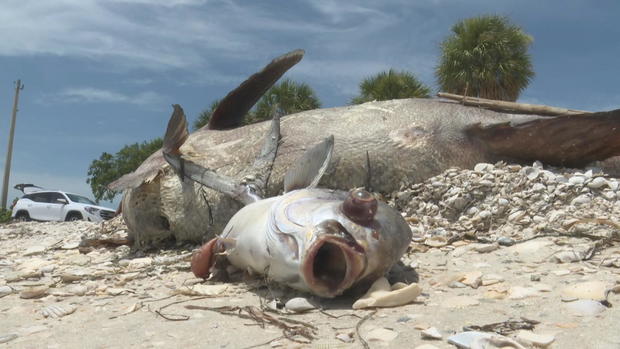Hot, Leisure Summer Days and the Ocean
"When we get a deceased sea turtle in, our stranding investigations program here at Mote conducts a thorough necropsy and learns as much as they can about the animal."
"Right now, it's very strongly believed that the Florida red tide is playing a role in the sea turtle mortalities."
Hayley Rutger, Mote Marine Laboratory, Sarasota
"People have really beautiful yards in Florida, and we want to have all of these really nice things. But you know all of this comes at a price."
"It's alarming. I think we will see long-lasting effects from this event."
Gretchen Lovewell, manager, Mote Marine Laboratory, stranding investigations program
 |
Fish, eels and turtles have died in Florida due to a toxic algae known as "red tide."
CBS News
|
The rarest species of sea turtles in the world, the Kemp's ridley sea turtles, are being affected, with over 200 stranded in the red tide epidemic, with an almost complete mortality rate. Florida waterways have been fouled with red tide since last fall, caused by a tiny algae, Karenia brevis, known for the deadly toxin it produces. Although algae is an important part of any marine ecosystem, when extreme blooms caused by high nutrient levels result, algae responds by high reproduction rates.
According to the Florida Fish and Wildlife Conservation Commission, close to one hundred manatees have died since January, resulting from suspected exposure to red tide toxin. A dozen bottlenose dolphin corpses were recovered in one week alone, including one baby dolphin. Florida Fish and Wildlife Conservation and Mote collect and test the bodies, attempting as well to save animals close to death if they are recovered still alive.
They are housed in rehabilitation facilities to wait out the toxin passing through their body system, safe from further exposure while at the facilities. Life jackets and pool noddles are used to keep the manatees afloat to enable them to breathe at the surface of the rehabilitation pools. These ancient animals whose presence in the state is as primal as 26 million years in the past, are of the sirenian order of animals. Fittingly enough ancient Greek legend referred to them as sirens of the sea; mermaids.
 |
They are nearing the stage of being placed on the endangered species list with fewer than ten thousand of the West Indian manatees left worldwide. The death of some hundred of this species of which less than five thousand are present in Florida, represents an ecological disaster. The manatees' main food source is sea grass which toxic algae settles on. The toxin is capable of remaining in the environment even once the bloom has disappeared, and for weeks afterward, the manatees may remain in danger.
Both the turtles and the manatees are paralyzed by the algae's neurotoxin, causing their tissues to swell once the algae is ingested. That state of paralysis prevents the animals from swimming to the surface of the water to enable them to breathe, and drowning is generally the cause of death. Shellfish too become infected with the algae and that's usually when human health becomes impacted. The water itself may cause problems such as skin rashes, but eating creature infused with the algae is even more potentially serious, causing non-lethal symptoms such as numbness, tingling, loss of coordination, vomiting and diarrhea.
"These shellfish, over time, they accumulate high concentrations of these toxins, but it doesn't seem to affect them at all. Then humans come along and eat shellfish, and they get very sick.""A bunch of people get sick about the same time, same location, and you could track it back to the source. And that's how we discovered all these toxins. There's almost certainly other toxins being produced by these cyanobacteria that we have not discovered yet.""If you see a bloom of cyanobacteria, you should simply assume it's got toxins in it. Don't go swimming in that water. Don't eat any seafood from that water.""When you start feeding these things with all these excess nutrients ... now you've got what we call a 'harmful algal bloom'. Now you've got high concentrations of toxins, and now you're causing a lot of human health [problems] as well as destruction of the ecosystem and so on.""This is not just a unique situation in Florida. This is a global problem."Larry Brand, professor, marine biology and ecology, University of Miami Rosenstiel School of Marine and Atmospheric Science

Labels: Ecosystem, Environment, Nature, Pollution

0 Comments:
Post a Comment
<< Home